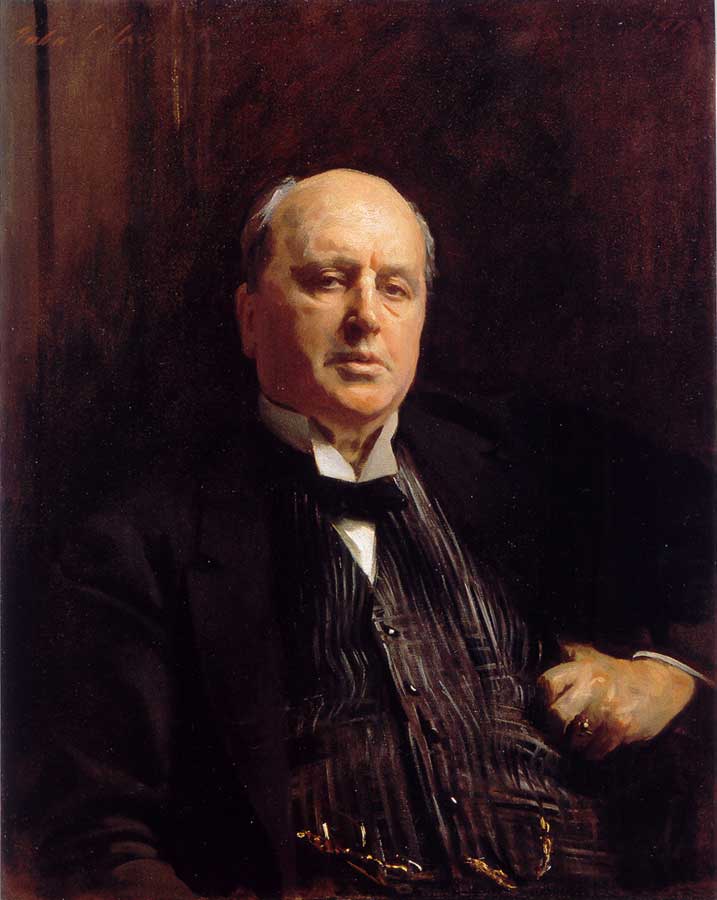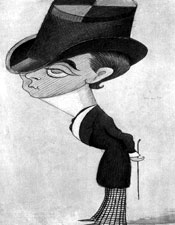5 x 5 Books … is a recommendation of five books that appears regularly in this space. Today’s installment comes from critic Michael Gorra. A professor of English at Smith College, Gorra is the editor of The Portable Conrad, out this month from Penguin. Earlier this year, he wrote about Henry James in Florence.
 You’ve read The Master and maybe Author, Author, you cottoned onto Diane Johnson’s Isabel in Le Divorce, might even have known that great old Beerbohm parody, “The Mote in the Middle Distance.” But James freaks can never quite get enough, and when we get done retelling our favorite anecdotes (most of them cribbed from Edith Wharton’s memoirs) we go looking for his figure in the carpet of other people’s work. We’re so apt to do it, in fact, that there’s even a book about it, Adeline Tintner’s Henry James Legacy: The Afterlife of his Figure and Fiction. Here are five places to find him.
You’ve read The Master and maybe Author, Author, you cottoned onto Diane Johnson’s Isabel in Le Divorce, might even have known that great old Beerbohm parody, “The Mote in the Middle Distance.” But James freaks can never quite get enough, and when we get done retelling our favorite anecdotes (most of them cribbed from Edith Wharton’s memoirs) we go looking for his figure in the carpet of other people’s work. We’re so apt to do it, in fact, that there’s even a book about it, Adeline Tintner’s Henry James Legacy: The Afterlife of his Figure and Fiction. Here are five places to find him.
1. “At The Grave of Henry James” by W.H. Auden. Actually I don’t much like this poem, which dates from just after the poet moved to America at the end of the 30s, that low dishonest decade. It has a creaky start, but it ends well, as it asks for forgiveness for the treason of all clerks; HJ was, at the time, famous as the writer who never served a cause outside his art. The grave itself is easy enough to find–he’s buried with the rest of his family in the Cambridge municipal cemetery, a slightly bedraggled cousin to the better-groomed Mt. Auburn. Auden saw it covered with snow, and my own first visit was on a bitter January day. I had a cold, and I was so hopped up, or maybe down, on antihistamines that I could hardly drive. But it was worth it.
2. The Ghost Writer by Philip Roth. The young Nathan Zuckerman sits up one night in the fifties reading “The Middle Years,” the tale of a dying writer who wishes he had a second chance to make his work come right. Roth must be on his third or fourth chance by now, so many revisionary selves has he put himself through. Or maybe its just Zuckerman. And James got that chance as well, in writing his prefaces and revising his work for the New York edition. What’s especially good about the Roth is the sense it gives of James’ importance to the self-conception of the mid-century American novelist, maybe especially his curious importance to Jewish writers.
3. “Lady Tal” by Vernon Lee. Vernon Lee–as everyone knows–is the pen-name of Violet Paget, an Anglo-Florentine and a childhood friend of John Singer Sargent. She wrote well about Italian art and also produced some genuinely creepy ghost stories. James liked her and admired the depth of her knowledge, but he never forgave her for turning him into a novelist called Jervase Marion–a name he might have used himself! The story is set in Venice, and other characters are recognizable as well. And while it is indeed catty it’s also highly readable, quite funny, and probably accurate in its portrait of his various hesitancies. Easiest to find now in Elaine Showalter’s anthology, Daughters of the Decadence.
4. Edith Wharton, passim. Which is exactly what one isn’t supposed to say these days, except that “Roman Fever” is the best analysis of “Daisy Miller” every written, and The Age of Innocence is all over The Portrait of a Lady. Not just because Wharton’s Newland and James’ Isabel share the same last name, but because Newland has memories of going dancing in Florence with a rather decayed group of expatriates–did the Countess Gemini try to hit on him? Also he’s a member of the Century Club, where if only he were real Newland would in 1875 have met a writer his own age, a young man giving New York one last try before heading off at last to Paris.
5. “Pandora” by–well, by HJ himself. Find this gem in the Library of America edition of his collected stories. A German diplomat comes to America, and on the ship over he both watches an American girl sashay along the deck, and reads a story about the misadventures of another such girl in Switzerland and Rome. Are the real girls like the ones in books, he wonders? Is “Daisy Miller” true? If you like this, you can then pick up W.D. Howells’ lovely Indian Summer, a book set in Italy in which the characters criticize each other for not coming up to the tone that reading James has made them expect. It’s a typically understated joke by the editor who bought The Portrait of a Lady for the Atlantic.
Archives for December 4, 2007
TT: Almanac
 “Come to me in some grievous difficulty: I will talk to you like a father, even like a lawyer. I’ll be hanged if I haven’t a certain mellow wisdom. But if you are by way of weaving theories on some one who will luminously confirm or powerfully rend them, I must, with a hang-dog air, warn you that I am not your man. I suffer from a strong suspicion that things in general cannot be accounted for through any formula or set of formulae, and that any one philosophy, howsoever new, is no better than any other. This is in itself a sort of philosophy, and I suspect it accordingly; but it has for me the merit of being the only one that I can make head or tail of.”
“Come to me in some grievous difficulty: I will talk to you like a father, even like a lawyer. I’ll be hanged if I haven’t a certain mellow wisdom. But if you are by way of weaving theories on some one who will luminously confirm or powerfully rend them, I must, with a hang-dog air, warn you that I am not your man. I suffer from a strong suspicion that things in general cannot be accounted for through any formula or set of formulae, and that any one philosophy, howsoever new, is no better than any other. This is in itself a sort of philosophy, and I suspect it accordingly; but it has for me the merit of being the only one that I can make head or tail of.”
Max Beerbohm, “Laughter” (courtesy of Anecdotal Evidence)
